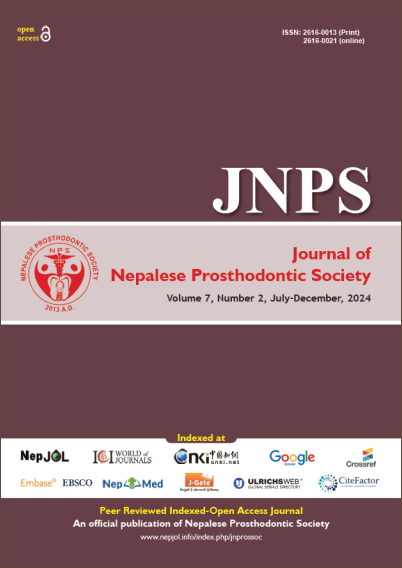Morphologic Variation of Retromolar Pad in Nepalese Population: A Cross-Sectional Study
DOI:
https://doi.org/10.3126/jnprossoc.v7i2.77552Keywords:
Morphologic variation, Pear-shaped pad, Retromolar padAbstract
Introduction: Retromolar pad is considered a stable reference area of the mandibular edentulous ridge as it undergoes limited resorption due to the presence of cortical bone and insertion of muscle fibers. It acts as a fixed intraoral landmark for determining posterior occlusal plane and also contributes to peripheral seal, retention and stability of lower denture. Various shapes and sizes of retromolar pad have been described in the literature. The objective of the study was to find the prevalence of different shapes of the retromolar pad among the people of eastern Nepal.
Methods: The study was conducted on 92 completely edentulous patients who came for the replacement of their missing teeth. The retromolar pads were marked on the master cast and their longitudinal and transverse diameter measured. The t-test was used for comparison between left and the right side and ANOVA for comparison of diameter between the various shapes of retromolar pads.
Results: The study identified four shapes of retromolar pad: pear (41.3%), oval (40.7%), round (13.6%) and triangular (4.1%). The variation in shapes of retromolar pad on right and left side was not significant. The study showed no significant difference between longitudinal and transverse diameter according to shape of retromolar pad.
Conclusion: Pear shaped retromolar pad is the most prevalent type of retromolar pad followed by oval, round and triangular with no significant differences among the shapes in terms of the longitudinal and transverse diameter in Nepalese population.
Downloads
Downloads
Published
How to Cite
Issue
Section
License
Copyright (c) 2024 The Author(s)

This work is licensed under a Creative Commons Attribution-NonCommercial-NoDerivatives 4.0 International License.
This license enables reusers to distribute, remix, adapt, and build upon the material in any medium or format, so long as attribution is given to the creator. © The authors




